The consumer, not the brand, now dictates when, where and how the two parties will interact with one another, according to a report from Deloitte Global.
Social media and ecommerce have empowered consumers to an unprecedented extent, and as more consumers adopt those tools, brands can no longer dictate how content is served. With polarized growth rates becoming more common but globalization presenting boundless opportunities, managing the digital relationship is the key to performance.
“Luxury can no longer just rely on China for growth,” said Nick Pope, fashion and luxury lead, at Deloitte, London. “The key is a richer understanding of specific consumer segments, their behaviors and the values under which they buy luxury goods – and increasingly, luxury experiences.
“This could be around transit and travel, around lifestyle and health, or simply around moments in life where luxury can make a difference,” he said. “The obstacles are the ever-increasing competition (digital business models have lowered the barrier to entry for smaller brands to act globally), and how to differentiate in the eyes of the luxury consumer using the levers of product, place, price and positioning.”
“Global Powers of Luxury Goods 2016” examines the performance of the 100 largest luxury goods companies based on data from the June 2014-June 2015 period as it relates to economic, geographic and sector-specific developments.
From digital innovation to discipline
In the period covered by the report, the 100 largest luxury brands $222 billion, a 3.6 percent increase from the previous year. Overall, company performances flew to extremes, with more double-digit sales growth but also more double-digit decline – presumably but not necessarily due to a gap in digital performance.

Chinese tourists at a Louis Vuitton store
Among the economic findings of the report is that wearable technology is impacting the ultra-affluent in Europe; male consumer goods are particularly fast growers in the United Kingdom, possibly due to the focus on digital among UK luxury brands; Hong Kong trending downward as tensions rise between it and the mainland; opportunity in the Middle East, particularly Dubai; and optimism in Mexico to help mitigate Brazil’s implosion.
However, there is also a great deal of uncertainty in the economy, ranging from China’s transition to the myriad effects of low oil prices to the impending U.S. election and Brexit.
“Brexit is a massive topic in the UK, and will knock on to regional and global markets,” Mr. Pope said. “The current mood is one of huge uncertainty, which affects asset prices, market activity, corporate investment (almost all on hold until June 23), travel/tourism flows and general consumer spending.
“The majority of UK business are backing ‘remain,' but there is no crystal ball in this situation, and businesses will need to prepare for either outcome,” he said.
Overall, the report notes a transition from a period of growth spurred by the Chinese consumer and digital technology to one that will be characterized by discipline. As channels merge, consumer behaviors evolve, international travel increases and millennials continue to become important, more opportunities await.

Japan duty-free Ginza rendering
The combination of travel and millennials is a particularly noteworthy occurrence for luxury brands, as it presents an increasingly rare instance where the brand has more control of the message and marketing. Air traffic is expected to double over the next 15 years, and young travelers will overwhelmingly come from developing countries – Turkey, China, Brazil, India and Indonesia, for example – rather than developed ones.
Tapping into this market means re-thinking the brand experience as it commences in transit and end-tourism channels aside from major cities. In these channels, the customer experience normally falters and fails to inspire, but as travel-related and duty-free spend poises to grow, brands need to respond.
Elsewhere, the combination of proliferating connected devices and of connected states themselves – Deloitte notes that the “offline” state may soon cease to exist – requires increased awareness. Its research shows that anonymous consumers are as trustworthy as friends and family, with 60 percent of respondents approving compared to just 12 percent for brands.
With this reality coalescing with widespread social media use, the promise of a great experience is not enough. Brands need to provide that in a way that encourages the consumer to share it with online communities.

Affluent millennials
Deloitte also includes a “table of imperatives” breaking down what each C-suite role should focus on in the next year and the challenges present through 2020; an overview of the top 10 luxury companies and steps they have taken; as well as geographic and product sector analyses.
Global changes
With the rise of digital comes the want for personalization, but retailers’ ideas of their own capabilities are often inflated when compared to consumers’ assessments.
A TimeTrade report found that while 69 percent of retailers say they are delivering an individualized shopping experience to customers all of the time, only 26 percent of consumers agree that the retailers are successfully providing a consistent experience across all channels. This divide shows definite room for improvement among retailers as they seek to provide a positive, personalized customer experience (see story).
While digital and travel are primary areas of growth, developing countries extend beyond the obvious markets of China and India and represent further growth opportunities for those keeping an eye on the future.
After China and India, Malaysia, Kazakhstan and Indonesia are the most promising developing retail markets, according to an A.T. Kearney report.
China and India are predictably the two most markets with the most potential, thanks in large part to their enormous populations, but the APAC region in general is full of promise. With retail sales in developing markets now constituting more than half of global revenue, brands must be precise in determining which developing markets offer the greatest opportunity (see story).
"In every marketplace there is competition – with winners and losers, and this gets accentuated in times of slower growth and market transformations (which we are seeing with digital)," Mr. Pope said. "There is huge competition for the ‘most valuable’ consumer segments in luxury, with the risk that they are being ‘over-catered’ to, and brands may be missing long-term value creation opportunities as they fight for the crown jewel clients.
"The key is being innovative but in a disciplined fashion," he said. "Innovation (e.g. new consumer acquisition, new partnership models, new profit pools) does not fail for a lack of creativity, but for a lack of discipline."
{"ct":"Jbpnd39FxcYu9VqW1qWxAnes8AQ0KXoB2Hab0DZCAuoBG581UvrkwPZd8CkDPnAIIKF6r19rvLoAGCD5Pmp0aYm0o\/OdjBGPk4dHQELNr4X3ZX\/0mtKOchjN790phv97YHC\/BA47s1vIQDubVA7NYUAjAGHPiCsHoijJejo3KS2EX3FFF07dhoKyysU40FRbU6AqETrGY5eva+uc5t7eASwrFbes04XvQu3NcuhoQschD4Kcx795BJldzE7IM21SwW67gW+e+TVT4x5Vdo6+EZIkRkAeOaylrnL1l\/zoNV1Trq+C4TATxjr7oocWnLv0Td1aT0NoHIz2ZBuJfaav6TMkHURHD9PuIksvLSXlc2bh7Djs6vtiJ7lnErYGnhCcuOySPWw+ptBASjh9swYMuJZypCMYMGAURuBes5alcHJm+dde0dkPkFyUCfF7r3JxPc9tdqgc6KjYaM+K8DkufAz97tDmfyeRDC0gM9R\/s9ijMXC9KfItRrjbPlgmmKw81eGiYYQDf6OTnyyduI7pizgpDDpnOHWc2qsFfhWDGJjm45xEBJWfQLa8uFWsiSJXgoaQ4GC\/7N0XMOorUPL30O5m+gS0MIH4CbJTaFYzDdCxfI4ntH0q7eMceLCkT7rL4q+hpHyPXd8BiybvJXi6bW\/jSfE2FudVUqTu3TEukgqjs7sIzGOQC41QNSn7yUgdvk6Totpu4tajYh59r6mfPMkXwjS7D4wv4L+meFMxCQd0R35D+qURP5i1Pq5LJCfeKGTiUc6nqQN5e2eno3BTkcnV5zplwLbccF2Kzd\/JWNEGSV+2Jb4wdBr4QJcOg4jo5ugpliNoqXGuhpMleyMTApUT6UHB01pBgpI3RlX3YMbgFnUDUY3C71DUy1rpYCbnuW\/ibxnKLi2yx5Mtp3Y+SJQtSBXwvXjXSiPNI3oafyIzlBuCmlKWRhrdxYyGuTboB3AJ+kOH+wZB9ga9xlUjxGvlbJEfBK6CRTAJlkP\/iOerO4PYO4RVQT7BLVLdAniDYF+fcM+rWRwqOdhjLkxVuaoLlC9Ve+3E6dBY+DUZIoxhGAZr+xl9afgciBFgfoUWfELBQP6kq8IWKpQzSXDJkHQf+6kWVCC6veVYTy82DE+Ts2BpZQlGnr5KfTREGMA6J3m60iOFnsBdMJMIvW7Z4oY6\/4Zms3yWHSvKp6DWNZL\/2muBP1eJJdbaQxPkbGyuJCvqnzyTPjjWLKW14BULUC4FMOyatbL272C2MLSK7WSk9w\/RnVC6zpIAQZ+sHT6WlMiCcfdStrRUjEXNkuAM7G+GHJxkDfLiKCpixXHewnSgoRb4gXeX7Uh+Ae8qX1nTYKQcu2OtbxTzSBfk0sFPqMsCsDze5mUSVrjxcnz5nwm6fHbPIVAu+JgNLl44eqL+5kH7gzDqa24XntnX\/iKFjSDwcJNF5qY2ZlGQe4eX1TclUYwVOovOY24X+br7ZcSnb\/j6UharCGx2q3Olu+zX4RtT5Ygz\/jqT\/9IDu8FvXoIXFMniYK9tDK9JwqvTeYAI+F6OXNjdraiNrzdyZvChgKDjFU1aFvG\/zD3452ejZIHKpdIkUpS1hYN2wFMtzh82PnOrb20boCXWNENqM099XBWatGJY28ECXA+D+nl1L54bCdx2ZkYuVll0BTPB8Depjuo\/bim9YWdVtnZX\/saTtcMuA79uxaY5or70sREqHFCNv\/R5wKe3L5AT0EdcXx\/FUy1AcN0WP\/sdmXq8r4bQDCKMVWvTfUpMdqQvYQRmAOxh4TP\/vpiC9U6isBlUC2js+h4BOYwNvtqXNy+8aQ+lkSsHn8QSav9FsWN5\/STDq6IKfklEFClgFxNTY3JNEWAvFp4\/rfyGUfwXqum\/JcQWaMtbDRWuGv6T9P2aR\/Iqn7Qd32Zp6OksZ6\/BcCP4RH4+skiumbq8pGgSOSqFU9UDzhqKcqEv4coNrQAl0bXXEAsESpqbOWtn\/mLfKBOjdUVWC\/js5E4V1l4+HNJKN9jMC\/KeEt1bwNXEqJHMfZWvp9Wr3vSyMPYJS+EKJWvvbY+3XVYCVcyLY+lO0OHJvluB7vP4jqi8quH24Xa6CG7uZo6lhkvkv2cnfC0+F1LTyPx6ZC6GBQ+5RH1j8iQpSiYj5kSd0X6aiZRtPs2mwxkmp3rQ+mTohdCe4dcb+qDLrleg\/jQ3uQzDoTWxWkvqZauZqoxPQ0q1JT+2nFwQsy1l8iHQSnfEuH\/rPk\/cQx980AfOOyo1VdCZlwp2kXc0qUN8Fyh2vi3pfUa68zB\/sqkil1WFaOu0eC9YPDGPxs+QU0RbJiohyGKaLOpJkJZ1bcMnwEUIYV3ylG20N4nSd\/XpVvgzrRlrbqLdphW7vWSXQzLyEPpK804ZWIha5qvs2PQq0yUFwZjmzrvWjVdX8OXpuQWJ2r6h4puycHtejHoz88Sjhs9yKXMkaDj90ReKiwV+ozZ1+SC5uYjDHxxNSugmfkwi62bkTwI87nH09i0cJKNwJ4GlnEq7EaKwQEHVGig+3Slz8DUwa66rmGGpOJAPd+wmtFAmAnjymXIUJyiv78U+7wJG5nWnslC1VakE26duv+PQx7mmWGXlcn24x\/qJcq2PucESKbRFVYijLQ7dSSFGKBw0afGALQqvzeJSGjp8UcKhaH6gxgKY6IGphkFWBoSvHyMgQOS+BPmdK32nXSwgTX5TXxuPURrkBasLzlLV43oGFdBRPO4BHBbjD3TpcCG5W7TAARqiq4+8DpB7tTx1xBluF1h6+Z0IIYfZbSwPpyCwpPRz1PLJMzrVo353fHEl98oaWYohPvXpcwiGZ0XyMoIHvVrKneTOE7gFZ7yHNbXTZCenFuo82eMJot1tsnEW0TdpBHXP2DwjmY\/sNzVqqYcbcxtEJQgNrZtabIFGwG\/roBypE9ZVZV+hNGnGAVjMz+WSTcHy7k8XLuNdnJAs0dgtNZQwWVRPC6ITl137SoVSI0oy+QD6NV07w+NwesZnRgnsL5wOX0NeAZAoW01mzY8ToAeES+IJzpuv\/KVOUYanlH3w9PTAil08HkOTw9LCpwvRBYsVrfyHoH6PQXJwgnxqK0WKJJ856mxA36t9+rzTQmypoDgcS7p8GL6zbsfKm8x3cKLiLxbESzwAbzgqA4wYmmZDVYcdR0yseHVn0ll1JY5k5SKrq\/7lKe\/W56nZGywap\/QtWDt1YsDHan5djR599tEuTP2TbC2MpdXCnfxcbc+XXLFl6S08c4HeGrIhHuscL6aVeN3LsVHOXOridsUva2T1VEDzh9v+dxAjHqHbHfxd+6fUlhGvPdxentUslFisYJuMMsVDxX9Ab2SyEbM8ILkVXEpERV7FvsRACQIMCaZQPnaWdHRJgrMewVnGviNR5qv5ZeSmL5dWdnFDQv8uE4ejH0XGklvPLk4JmwTnY\/40IR4bxAGEqrYDWFv8sJOgOCiUou\/ltCowuBdHe2cVe0vfNwfTjOx8nGRF+D05A66y1ikwvKvZXPnwRmqa6IkioRaOmGC\/Pbwpzqjtnz+gF5aqtHwSsHMkcyQ2yApr5jVjPS3GPLkenw2dIOdob1OQPcGvyTiZMSUe8OXGvxKBNMRpPW0zB2eZ3LUd9l16qlbZkAFzUPPMei0nrXpKG5B3hCGA+epQUNR5NuvCNaCxXmMbEw0+Y4wXkKCdxW6f5Yw2QCBWaQM9djOKLmCBrxdQwtdCLXtM0Jx4hSHgc4pm3Y0yniNSIbvzdljUbc5eCTg4Kb49bXn7925fQyYVAI8nK\/kkV77fDZXQzT\/qoIO0lwqtK1HWeHXG4YD18cSty6Xk+2LLthJKi7kqNY1tL4vXveZV8gyk3xhlJpZ3C5DDXOfn\/x9p0FyGIiGfPdmWJgKkdihdHa2FZiKFKaNcPfUMNZJT2RKgH41jFNLahrisG+HmzRai7zYLjof7VEoRDHcd+yD2XvQSwBuU8QKxKA9qfW9ELratPWeiWAZCoyuHcaBnJ4FLM2DkPPpNFKfAmJtbEG3Ny2M+e+PKyjG\/yAophf0nigYL5Ko6nveEvCcmBBQcY+ubqrDlQ22if3cDbvbyQaibHnNH\/3uWiEPXn6ej7uQlQcDoaR3ai\/m683L+scVa4NOFWhsWiBxhdfFFQSIrYVNttEccrf1OKh8XpFMmcvm6ySe\/TWMN88yFl3KyReAjX\/6Chn\/7Og2GmZ7J9LNFYse8ISG5s+GcZ1oBUBFfXuky5wWrvGaUaRI+\/eB7XeJofMebnNvTeQgF4L5zEogROV04ZFmU0h4A6Y0Y0jD+YdQdB9gnNvmU63avbZ9GvO59SQ2UYz9QBBvU8YYhP2gchlhaBZPCF+1jgNEEhlGvdQZgNP0pkWb62S2qtvqIq9p+\/1zR9Ecftf30Ki3GItcVtuDfE+bUgvxrdg+tlde4BvbgnAtoUqy8vUAO0O8Jlnd9\/lfu8E5N9QjlZ4z7ttRvPqITc5SidnPoVNlDdTjXsEcklk+YL7aPVwoCRgZeoDIvHxvhQCfZg6dLOZIRRUQfXnqkISkGxZbcbUwVqM7bma+7HK9NvzP4A\/eQlF4ihKlz6xxRoaagvirWyac\/C\/MJyrMQuvXAMrnBye6JLoCfmoXyRHSgjTwgLjYjSF6cWnP6vCHb68S0OWDkRvMb2kRPjp2HwxAGpSxctkriiCckE6oiwqjaHk6rYXqP5A4VDHd92SqjPk4ut4LB2A4wiKpiBlb0AO3whHbOoJmZrr90UuyDK01N+Uuw1fZ7UCdI3IT8TbsdhH4\/xInN6OclxIwfdgmAyMLcXauVXJwvBkfnmRXuNN4+YU6m6IF1nU4K+Y\/qFjOPwCQR1QoifJ9HHjM5wEjzkiYaHfFT67e9Sm+vS\/TdDuR\/qo8xzFOhtvgKVKF0rJapN1KV3KWYaheZJilfHAw38ZTwzYIpyKJjH70kMNojmFtaB1+Nbk5t+li6+ra\/B3w\/9wLliR2L0TXT3DRcUvP+yw4fGW8f3AmpZ6n8VDM3aUdCAQCtBMlzlDkXONWLZRRM5pVWOA53bwOAtzjWQE713Geb7Xjsq+wz5ZUJR78tAa\/71\/IwLTx0cpDOEkMvsvE9v6q5+GplG\/5jSynbsEUm\/eaz\/8mpOhse+Pva4rtpLifbrGZ3oUpg4zfeOv\/aJoM9iioQSWOLvgIlXS2UE2zlZze5LZtEXsoGfoN9mmdtq9xdoF+RybdsIZJnWWYuwYo1km8vjXDWe0kq0npzw3HBxCwUFnmRmnVd6kv2C0wKvAteRMZ9J+yoRY+DWhVVHHviZHOFF\/PpRLo1F6Ma+DUJ+kx6gakdAkaICuJFv3rokoABAMO0GvwcRenSvXX7VUUadE6B1mPByDIouCPJ\/ooFm0LwA9L1rTUrsoqvxgw3s0AnNzPmpBKes8ZYTuje4czCZ5c2HDCLRTIjHag2FFw4I+lxTcqS4Xl+96cX9O4+AQ8bi8Muq5vvaJGI+ysbuBQbr6bCeXK5tap9svEGmbg5ekJ4q3cXitsoS1rX075QvWOOaZBXc3wEZm0efTBoM\/ma6YziirLszHMi9MN0J0CHKUV\/6KTGfgAiZDKGxuGaNddMP\/1z9QTuQpoufHYPZxfM67hgjYlOBYXLiMCjnAcDtDLnvUDThFTc66CAhaByBcQcOa\/+1XhLAS7uG6wFVTuBJHOcwEjTW9CL\/wdFUOkIhMmBGtKxPyzfUQlX5v+PWiZr2HozOXiqajaitN1j1Ifp4flPeG1cb374fBK3Ohp7IHFcusSTbSd\/dWZuMt3lE8hE7tnGjdCD2YNFj1jpk02rRosTB6ptraeagzWox6aDcTi\/\/nottZJ50ePY1XuN8385VTcM25tF5i3f7qH0U8ZK1TVFLkvYoMFLynK2WdOLiJ+LmawxtwmOHHq4KvNvJdJCfDguOJ7wmr5d\/5rro8fMZJAlrZBdEK6qjCbnTZlkSLJBaFgSsi0C3Ujc3MAABJeMDGOWBE8H\/79OsSd+mCOdzq0tPQqSq\/EL+7uj9AeDINeY7dzdnyuwAKKyarU7VGSWp\/KfQbbgRQcT4qEKU5WdSqwCf5HdpzRVMvZP\/aslQPhTqtaQZWN7K6OauSv9xfeOxNIXETMhCMtY2BC6HdPa+BdmeFhtiWSZlXa92sxYqfA2LdJ0mDhAIai\/jBKwW6GjfkdNkCAlwTzwM1YyJqzt\/JyhR7VHqg4c3Nkt\/vwvCKD\/FZcXwgo35KC1IBiZL0sYYE9kRPsHNg4ImhajH2SXuHjFY29ACEN48+n1BcBNfKkipVPONVvXmhMko\/+J8T1wBePn7WLw5GE9uu\/zRcSTJT9UXr1n\/rHbKLGfSKSDVS+Wez+YoCwdOR5cxoXAPpj1ciOSglSC9EKuWoqE2VLSZJ4fU3a+EEmm5tQ7UuJpHZOrtlFpLtBATvL5Q1N22uFuh95IJC08BeRXmK\/HDOlSZ8JT7uycuwGGctxGxQZU\/ooXsVhojLCmN6P\/LCXePeawFl\/LCNBYbnd7SGN0gIsfy7jxkhDdsggB57xnkdOFLULykYoiJ8sUF1HzJakvo4ZadLq+ZGr6YrtIpep5RZX2c9m+Z5gyZiQBPROUO0gqp2xzm4mP+HQer5WwawOEKHf3rgQfShpkxkHDTLFUpCLtgXFfImGKl+lM7silU2Nbx8CBqdwpfq7bFn2l4HD\/sNwYJjhj6KmKtzLJ51nQcvhnGyTU9bB0Rgf3EWYhaoc0JNuZhW1YnWxRgwEG0\/M8ZnYZzpJvg7hgn\/KJmzinA20dSCCpjNvnC5l6f+NAyNk8JJXDSWGTcwzha5wVDB6T6\/7BOxn3yTlJ8xe6dshH\/6tzB+Ytn6ROt+dv4clwc\/wmI0uguzlAqMbMfMlni6wvefljhrGe+dr\/Swf8PKQNvHMzGNiI2RAywayyHuX9DA0qWtCUtEdBpMIUrHvWs+OePkjFwY4RdAJIY69BRYH+eq9ikAZfk+4ifrxJxG7p+mNP9gLYelYp6Aq7vBtxwTBFBVuLpsJEza3EXHkjO3Ly7OV5aBBw2D7sKXQbzZO79pDr1wbudutsO351gzfxf+nNvXyQL6lqGtr1wcE\/eMaF6F3adQBZe308a7+K0Vt5WbYzA+RRG8TYRix8Nu+Zw8CqbKo9BfMYG3Y6kkEDBpRUVXl8IXuf8oi0qEsCt8OnQbUaXO1kEHayayBA0wOECM72Jmv6LYTU5\/euM\/O\/6snnWN2ohCU0OARkZ65syMrqLlPb0PPuXZnpDtj3xd3xG1aE+p\/DGH5y6ScBq3yS4OJWQ8tGKWSCnmARu1wV9DdOsHJJsFxKq8gc15W89zZPMCboRB8uSwjbhWzPlClq6iuSQwsYaJgpvj6HHTVC1jtch5Xa0ICqTQBeXoo48btofrRi5MzrrlNqL5qc0A81SThORDcKmyaCf\/jh6FXax8yQITJOK45niVW2M9JMmwU0cAXhsB\/O1FCyiyQv31eM7t7UqxHu\/FTE+I9evxjX53MJhAjNcFc\/DaN8\/kVnjknDJ2lIsPsUblcffr0yX5gHIhMsMD09OyG+EJ7PmUBvQQ+rjki+EnV7FMouX5JiLnk\/U957HNgd1nhu05L4KojWl5Kvd+SsyuJ1f8siFIwQpkIBCpKV\/h\/VzsEhoI8tIQoXm4MVbfSX\/yyhXdfErGixCGXNdKno+yswZ81vs6eZAOM3jPFZgaJEYEU8UW0GhpK5Q33XkE9yc3Cpcq6rQDMV78QH3t7NUxOr06TwXvrPJoFIQGvqHMfjKRptkbHVPZzDBHDIt5EDVj5KlFbDKHRthLgPSH9h1EPPWBc9mUm7HBEVp6qdOiPMexkziu8jA11gpXe6o1LajcBHFbigTJ1JSu34yEaYGxFVxzLmXeZfxns5sBkXQGBvRqc4WLdRphxbkJIcfU\/cygfiwEupRrn6JmRB9AEY7V2Gtul5z4j8Kr\/f7KzexAtFbAh3zS+m+E80edhefsemZHIwqCWxNqUmUi368FH9FZ7Lym8dy3BBPdZgcd5nmh91m3kvB7leir7K5Jezk3efabp3Ok3BUtc4deBB6DuiYkxsvC7B++zVvVmhIO\/OWHORxgTmTMrmpvu+BshnRB9AB72VQc07DTYxeCf26l2lIrnP6f4\/66iHYjWGsMQlbd8AmPDMJja28Ave6oG\/CgEwtFZiRswrbLlivai+30Uxzta8Ka9XyGfUChQNDSoLydHLSbFyJCAKdyYJkyI3xrzU4CiSalVz9LFsLbPMlBqtsYiLGKOwhr0hdQuDfRpICwV99oLZwLU7Sa0NMA\/2QZw6tSkeuczxkNaHsKB29K82wdTg7drYmjsrnDoF+l5h8U2+yiHopO6L91T52K\/I4Cnqropm8DEHAbU89EiSu+f3rg4muARzkL204IqhQWPNhJPyTCTT05n7EHqgTvR8A2G9uuAb8573oS5n0livVoS738QJCzQJOis22upL63JZgJh7WsJevzrqjqBOTOW2vHi8AJge9FiQEOv7\/MRtPc0GJNBONGiwTqbvskBl+kKsKIIzFHXROjqE6lhNS5wCIPwSGf1o8LcGXosibUDxewObGAgt0gSMWrtjneZu1Oz9BRhaIIZp7NijUDKruVy\/BrLLIkbd5LWY0VFJS\/TM0eUMWjHTSmc1L9qv67fPrCkGK0P3tLnRd8hYHC1cV0PbMLJQajo83Q7mrVBzFUPWCMCFUpU+PKmjRv7tK3ag0dteSFJROvkiGlmF0SrzoDZQ0hRENY2QJwSeqlcYPpLpdqTPD8y0+rjJnuC55ISGgYyWUnh5KdKeMDN7h7R3\/eK4IFuqplzaOiivy3W1dd+mbl2PD7cS8pf1QkRce484S\/q52J6SJislQ3bEq8miHihp9NhNk\/fNOBFdFFkcre3cjYOeoaZRE8SOJsaG+QcmDy47k+dMEK3uanyCSuNH3+xLbRRIAABi1QvsnDmJtoj1snjJGa8YaItzKNMJVTGFhmOGXMY1v1yVDaKmR6W+TkkFYC6HYbmkce24JRjf7tV4BX2xLqI0bJlY8GK9cz8PW\/jWCtOxm2WQZEWRQogWMOxfuWU0XOvFwgVPVfSQTbYSBtZrd3s816t0HSn53k8DLdXm4Wt6OeznLVw\/RCTFQJgDSTqDghU0fMt+VbwL\/g9lPZZF17IXbQRGl4DdzByYmn+1FjjliCZKPmRqFEWKk+7R+XVMkkCXJs3nLf5UvIbsYDSUl2RgCa2n0HPXkZPaSDkbAcVYjfGPwFfWmaQAB6N8rYj2WorXyKtslhWBqZbxL6NjUci+LkQzIz4b0nhroLkylVu9kvE+\/ANzj+bAY+UyayEPdVk2sW8nizyXqs31LPdClZgxgOzdmbJlD\/p6pIaD+59bZys4hrUrh0847BphXJgWogSZ23LbfA7S3sIvHF+vqA0iE12aQTHGfptDcoD12Oz2txz\/grVtfyMmeQvtFVS2GV+FKSp907O2dyOu8EnJEDptfh81bWq7YxUyXxFRFHVAHsaArN6VpFPS+B7MohgIFGkJuR5jTw7H7ymCP9W4xa5msPS9kLHKkdyjMsoK8we+6+iMJfxDYISVU4m8VtzYvFFv8VQfEG89gRxdYpbK1\/TxOA8+gMzICWVkm+W7vNIm2vSwRreSQqjeKFYHeW3kBKrVb8OMS4LzRWkP6rpTfT7eg4bNhGC+G5IK9NAUJTNkEOznS9KAFn8Q4oPs42xDQ6Q24i5LhH6b0p0W5jL0ku6oD9GrukfkJlYybu\/zU5i2kvjCwnRrenaZXnsS2H82CNeMOfWhLV3CZkO6u8vmx5ecdvBKbCJYMCX\/mMwrMN+JL6PAI2LpBtM5qF\/Ii94MltqHuC8MKAg5ZrgSfgaUbTo3cbYlZapubRSva\/jM8i3bbGWaKIl0nqi21u6TA9vcizurhlIXNG\/Aoepmz13hiH9skaeviM3H8AMJKiUCzibINlvkTFrGqjQq2sLUF1BhU3p2sWWsT7f7NxaHIu6uqBurdXoEhsqffD6tTMga0LBVV2eYyrcTqltTvoDyliAfe3FmdE+bT4b4m7FgQV66jiUy1P3iYFd\/rcbG5TfpzHkuF18imyb3RHksMdA7GFxSrzbD2CzReuCzmKiGRujOCRgnUebxijtjlFIWDv7vTDhMDfUA92BVNsK3t4Ae61mg3S1oILrEBkg+0jHaur6O7kWTZly9pnNg+83S5YYPiD4pus\/1CoI9BNxE8oQvUa16\/NKG8qcLNpGSU5n62px8YiSCke6gjTGfgY69BrxETT64\/5DygC7tG0HnCDJNE2UgnVrNlDPJ9+Hz\/EpOS\/tveNOrWrjZ4JBYVbbF9IAqd3bVmDRzNnHzDBCyAnuA1jBPc+8ote+LpVKdeh54fQ2CG2+oxfeF9nsn2JerbViYdlimyllDrKw0pyn279OE8\/Qqvfc+XryQ1RJv0hBeubulAWuyCALVfEUNs5P++0Sv4R6wJkA8c8EOmM42Mfw97LTEb+ppj9K4z1WGUE1xCS2mAjVBsSbJ4e0S8RmVp72BN\/WJvN4vCBCM0w0k8KOelXMNrOocqFmGINX+1TWNXUJFhsBmVF6UEondoqiKPi0zdwNH7aFaTvjRe13LOlGfwFEPEK9EWSWEIZTfOJTsF+YssI6tkDzZFlkV1qZES\/LI51N0WtHJqmFuW+TsOch1e49n4bf96KexkECCK3C7+hVOq7xZFPMWTK3SZM263KqZwmoECNGuDW+2\/PtUBS\/zmcsOpIHXt+s\/rUBYR8qhbWB58a3n3w+SqNm2nyHeooApiBDk0kbJuXTxfg9UW2LJZtqiXwft6oRj1YPD2ix\/vOTuJdoEyQqofegORhvbQB6fgnTve6giZsirXbSsFB+7sKTL9iWD2z1DFNjtJA9kDmCAlnEG3NC0dBt6On1pNIlSxSEqKEqtbW6kV2SRHxxv1XNjjclvH\/L6r+gRX8rFMymJ3W881wubIN6\/bEg4OdCZBV1xH8appCJkuYSbx6Y3gpuNtkDLFAl1gWbK5NxN0xFuwN8wWiyr3vb0IVD9+IhD8qmIBKSQ4xrtvwlFLWhHL4DcPT2lEvVdpqiPsiw+nNePtz7QY0E+7ZzOtB\/bnHk0aBXzDC7o7ks+QEGtPSeDyjHRE\/qXZGNdwBQlh\/lratR02ScUdgpRXYTSOIaQndwEtwWSJBlXlRy6YagQrqXY2mi72R+2sxUIXgdECm1oSonIqXdsBYDUcPuNTCHTy4pKWtHVnDnOaobrCVGFdBa5hN5alre43bkjEl0YNtbgqtBAXK2Vn70oHDV3v6ybG5uOqkxSFW9fX5bVU87J8nPzjaUs8nTST21bzW0XQWNZgkOxPztM3mYl9G\/DVUnPDVwoU+jGf6BKhVizYfXtwKIJhyvpMJl\/GmrnwIlRAqIsY973bgnFg6\/vu9JvBLcBCSiYMh9uvzcrhYwiyjZh81qgH6hCsfNOVw8O+Mqu\/Vpn8UpHm0NctFNQGSrXH3qLaX5sfTn8ItfWnF2taBfyy\/ZXO9tUylPYhO0ixO1WGVlgyC3hykwq5o02kXQKMRE9eAgHz6VTOOONWTF74EFJAaSTyslDtbtAUY+Ji983vlcwxjEabL9jB8YpYvvNLVp8ONWFpUejqqzlSZ97lT4Xh5Pca87gfOiu9nIYDg1G9zLIlR7QPukMUIzooOFpLXVrbcpwqDLfNs49SMxbjY\/\/R8qSgWK9EnV1RcDxkvbezmHLER+VC89kBo8f82CQnslP7puJrrQvyj83mOrcSKNehpEVKdNlorfnbWwIO1z8B27jLYPrhwtiGLnPvcESoilG9UhivEFVZf2uEKDOGOEcXF7JWu0Nsm3S5i7SHJa5KzXqNUhCSMkgqvSzTeYQDv\/CaSIkwHHVhLahDidBo2pnJr9PvdSvWwGuB7w7LLxQecsa3o5qw5P6J4UVZ0lKU4IAsnjwd3roP6NPUvVYPQrc2x14W\/nOC6L2gNCAmn\/jjAZpqNBuAJ9I9F67ilSIPOtMpGbxZGst1Bg61aE=","iv":"14c808faaa66dffbe00cf0bc57c1a3d5","s":"3fbfb5544e1b609f"}

 Image courtesy of Bloomingdale's
Image courtesy of Bloomingdale's